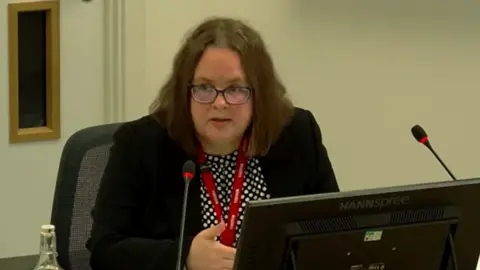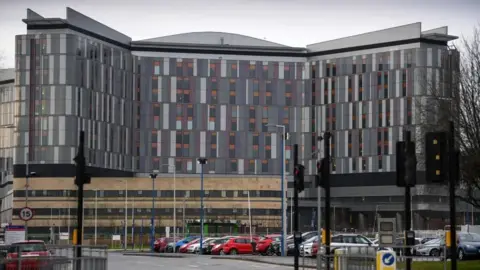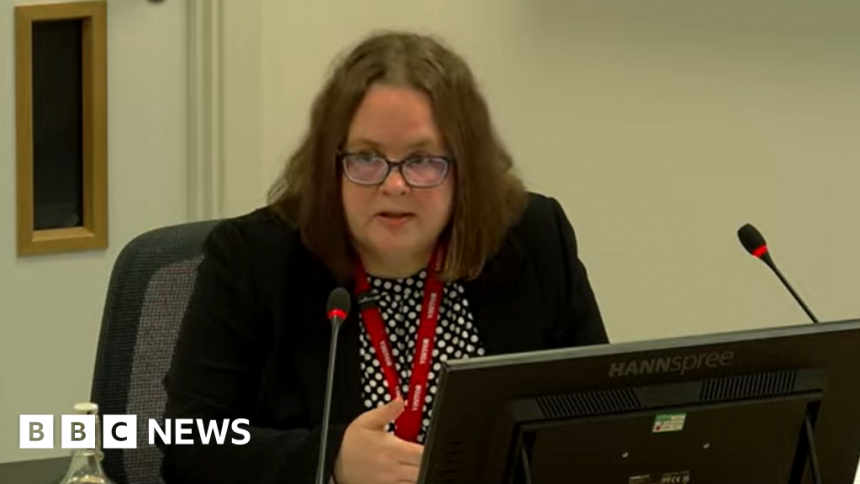Senior doctor ‘appalled’ at state of new kids’ cancer ward – inquiry
 Scottish Hospitals Inquiry
Scottish Hospitals InquiryA senior doctor has told an inquiry she was “appalled” at the state of child cancer wards when a new £870m hospital opened in Glasgow in 2015.
In evidence presented to the Scottish Hospitals Inquiry, infection control doctor Teresa Inkster said she felt “something had gone horribly wrong”.
Dr Inkster was the lead infection control doctor for NHS Greater Glasgow and Clyde from April 2016 to September 2019.
During that time the children’s cancer wards were forced to close because of a spike in unusual infections.
The inquiry is investigating the construction of the £870m Queen Elizabeth University Hospital (QEUH) campus in Glasgow, which includes the Royal Hospital for Children.
It was set up after a number of patient deaths including that of 10-year-old cancer patient Milly Main.
Dr Inkster led the investigation into two cases of cryptococcus in 2019, a fungal infection associated with pigeons droppings. Two patients died after contracting the fungal infection while being treated at the hospital.
In written evidence to the inquiry, Dr Inkster said on a walk round of the wards at the Royal Hospital for Children in July 2015 she found “holes in the ceiling”, “dust falling on her head” with “workman drilling holes with the most immunocompromised children present”.
Dr Inkster said: “In my view, something had gone horribly wrong”.
She told the inquiry there had been issues with water damage and ventilation systems being “poorly managed”.
“People don’t understand the need to remove all of the mouldy material, they may just focus on the tile that the water is dripping from, they don’t do full inspections of the ceiling void,” she said.
“The material that is left is a perfect atmosphere for mould to grow.”
There were not “sufficient accommodations” for children with compromised immune systems Dr Inkster argued, adding that whole wards could have been “protective environments”, not just the isolation rooms for the most vulnerable patients.
“I observed myself that it was very difficult for children to be confined to a room for the length of time they needed to be for bone marrow transplant, and I did see patients on occasion being let out of the room and into the corridor,” she said. “I can understand why.”
 Getty Images
Getty ImagesDr Inkster took over the role of lead infection control doctor after the resignation of her boss Prof Craig Williams in April 2016.
In his evidence to the inquiry last month he denied allegations of bullying, saying other doctors had tried to undermine his position.
Dr Inkster, however, described working in “an environment of suppression and fear” where she was told by Prof Williams not to write things down.
She said she and another infection control doctor, Christine Peters, had expressed concerns about what they were seeing in both the children and adults hospital.
But the doctor, who joined the health board’s infection prevention and control team as a consultant microbiologist in 2009, said they were not taken seriously.
“I felt that myself and Dr Peters were being labelled as difficult and risk adverse,” she wrote in her 391-page evidence submission.
“And that, that was all there was to see here, that it was personality issues rather than any actual genuine concern that there were patient safety issues about the issues we were addressing.”
In her statement, Dr Inkster also said by the autumn of 2015 it was “clear that, at this point, there was an awareness by very senior staff that there were issues and there were meetings taking place.”
NHS Greater Glasgow and Clyde does not accept that three of the cases are associated with the hospital, nor that there was any causal link between cryptococcus neoformans infections and the presence of pigeon excrement at the hospital.
The inquiry continues.






